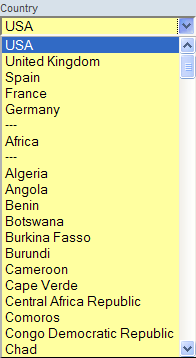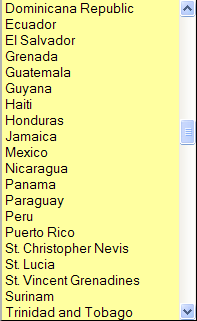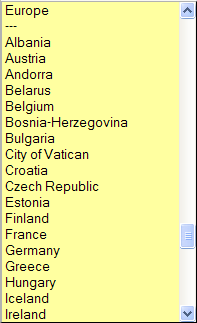Actually, here’s how you p*** off 22 million people… Ignore them!
David Pogue, the technology writer and blogger for The New York Times, whose opinion I respect and whose blog I read regularly (but whose Twitter feed I had to turn off as it was too busy!), was the keynote speaker at the STC annual conference in Atlanta on Monday. From the people Tweeting about his speech, it was excellent. No surprises there — I’ve seen some of his TED Talks, for example, and he’s an entertaining speaker.
However, one of the Tweets from Kirsty — a fellow Australian and friend of mine who is at the conference (I’m not, so this is second hand) — said that in his keynote Pogue had suggested that drop-down lists of countries on web forms and applications start with the US, followed by the ‘most popular’ countries, then the rest. (Update: Char gave me context for this — it seems he said something to the effect that if 90% of your respondents come from, say three countries, then put those countries at the top of the list. I don’t have a problem with that.)
In her Tweet, Kirsty disagreed with him saying it depended on the audience. Kirsty then Tweeted a link to a page that I presume Pogue had used as an example of his recommended structure (someone correct me if I’m wrong about that). The page is http://www.epsmaps.com/signup.php.
If you look at the Country list on the left of this web page you’ll see that the field is populated with USA by default.

Default country is USA
Then if you click the drop-down arrow, you’ll see that someone has decided which are the next set of ‘most popular’ countries.

'Most popular' countries
After that, the rest of the world’s countries are listed alphabetically by continent/region, then alphabetically by country within a continent.
Doing it this way is interesting, but smacks of ‘we are better than them’. Who chooses which country is the default? Who chooses which countries are the next ‘most popular’? On what basis? Population? Internet usage? Political alliances? Eye color? (see Update above)
And who chooses which countries belong to which continents? Africa and the Americas are easy as they are defined by ocean boundaries, but what about Asia and Europe? The various countries of the old USSR and the Middle East might not be happy with their placements in the list.
But the BIG one for me with this list is that my country — Australia — is NOT in the list! Not only is Australia a country, but it’s an entire CONTINENT! With some 22m people, we may not be the biggest country in the world as far as population goes, but I’d take a guess that we’re bigger than the Maldives, Kiribati, and many other countries in this list.
Below are screen shots of the entire country list on this website as at May 5, 2009. I have not doctored these screen shots in any way. There’s no mention of Australia at all — not by itself, not under Asia, nor under Oceania, nor under any other continent. (The reason I took the screen shots is that it’s possible that by the time you go to the website, someone may have fixed this glaring oversight.)
So here’s how you annoy 22m people — ignore them!
Of course, it’s possible there are even more who are annoyed — has anyone noticed any other country that’s been missed? If so, add it via the Comments.
Oh, and the real kicker? This site states that they have the ‘largest database of free and EPS maps’!! They deal with maps every day, yet leave off an entire continent… (actually, two if you include Antarctica as a continent). (And they are some interesting spellings of some country names too, especially for a company that deals in maps… Cambodja, Srilanka anyone!)






















